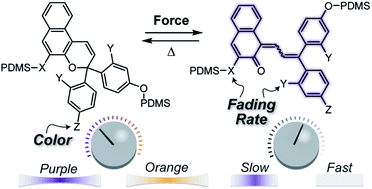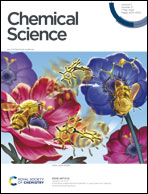Designing naphthopyran mechanophores with tunable mechanochromic behavior†
Abstract
Mechanochromic molecular force probes conveniently report on stress and strain in polymeric materials through straightforward visual cues. We capitalize on the versatility of the naphthopyran framework to design a series of mechanochromic mechanophores that exhibit highly tunable color and fading kinetics after mechanochemical activation. Structurally diverse naphthopyran crosslinkers are synthesized and covalently incorporated into silicone elastomers, where the mechanochemical ring–opening reactions are achieved under tension to generate the merocyanine dyes. Strategic structural modifications to the naphthopyran mechanophore scaffold produce dramatic differences in the color and thermal electrocyclization behavior of the corresponding merocyanine dyes. The color of the merocyanines varies from orange-yellow to purple upon the introduction of an electron donating pyrrolidine substituent, while the rate of thermal electrocyclization is controlled through electronic and steric factors, enabling access to derivatives that display both fast-fading and persistent coloration after mechanical activation and subsequent stress relaxation. In addition to identifying key structure–property relationships for tuning the behavior of the naphthopyran mechanophore, the modularity of the naphthopyran platform is demonstrated by leveraging blends of structurally distinct mechanophores to create materials with desirable multicolor mechanochromic and complex stimuli-responsive behavior, expanding the scope and accessibility of force-responsive materials for applications such as multimodal sensing.



 Please wait while we load your content...
Please wait while we load your content...